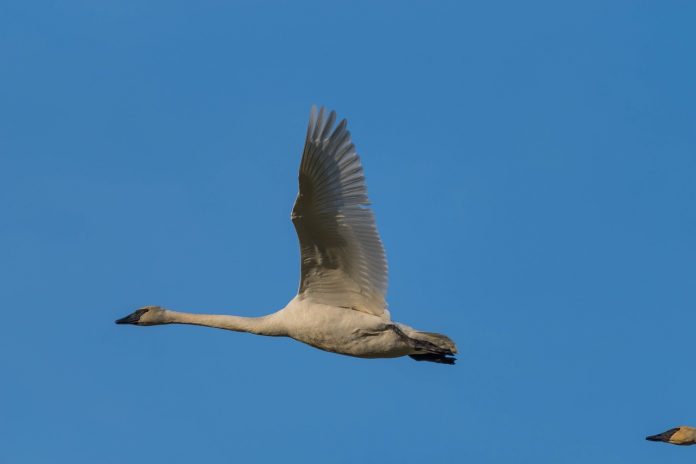Due to my sons’ recent interest in geese and other waterfowl in general, we’ve spent a lot of time observing flocks of waterfowl in the sky.
While ice fishing, not so patiently waiting for a bite, I spotted a flock of geese approaching the field by the pond. As they shortened the distance between us, I realized that they were not actually Canada geese. Instead, they were much larger and all white.
“Trumpeter swans,” my oldest son swiftly identified the honking travelers. I had only seen real swans swimming in a placid lake at a winery. Although beautiful, they hardly seemed wild and free like the ones flying near us while we were fishing.
Massive
The swans were massive in size; the males can weigh around 26 pounds. Their long, slender necks and nearly 8-foot wingspan added to their impressive appearance.
Looking at the trumpeter swans and thinking about their ability to fly was a little like viewing pictures of World War 2 bombers and wondering how they ever got in the air. Trumpeter swans are heavier than any other flying bird in North America.
Watching them take flight from water is like listening to an orchestra. All the different components synchronize at precisely the right time. Trumpeter swans use their wings to create lift and also their webbed feet create momentum in the water. It almost appears like they’re walking, or running, on water. The continuous and graceful flapping of their extended wings help them to defy gravity and take off into the air.
Mates
There’s a reason many couples choose to have an ice sculpture of swans at their wedding. Trumpeter swans mate for life making them a symbol of loyalty and trust. Male swans are called cobs and females are called pens.
From our vantage point, all the swans had similar appearances. It is difficult to tell the difference between cobs and pens from a distance. By observing their behavior, like a pen incubating eggs, a distinction can be determined.
Trumpeter swans frequently choose muskrat houses or beaver dens to use as the foundation of their nests. Three to eight baby swans, called cygnets, are usually born with soft gray feathers in June. The cygnets will stay close to their parents who help them find and reach food in marshy areas and wetlands. They master flying by their first spring and grow their signature white feathers by one year of age.
Survivors
Once endangered, trumpeter swans are a successful survival story. They were almost extinct in the 1800s due to many reasons. Their plumage was desired by different groups of people. Native Americans used the feathers for ceremonial dress and sophisticated ladies used the feathers for high fashion. Quills were also made from the feathers of trumpeter swans.
Ohio began the reintroduction of trumpeter swans in 1996 at Magee Marsh Wildlife Area. Trumpeter swans were transitioned from state endangered to state threatened in 2013. Since then, the number of mating pairs and cygnets has steadily increased.
When we spotted the trumpeter swans while ice fishing, it was the third time my oldest son had seen them this season. Of course, there’s a chance he may have misidentified some of the other flocks.
Look-alikes
There are some other birds that have similar appearances. Mute swans are a non-native species that are a threat to the survival of trumpeter swans. They look similar but the mute swan has a bright orange bill while a trumpeter swan has an all-black bill.
Another type of waterfowl that looks similar is the tundra swan. Slightly smaller with a yellow spot near its eye, it can be misidentified as a trumpeter swan.
Snow geese are also white but have black on their wingtips. Size is also important to note; snow geese are smaller than Canada geese and quite smaller than trumpeter swans.
He sounded very sure of himself and was able to identify their distinct features. I prefer to believe that he’s right.
I love a good success story, especially with such a beautiful creature. Why limit swans to fairy tales, weddings, and wineries? They look right at home, majestically swooping in on the edge of Appalachia.













